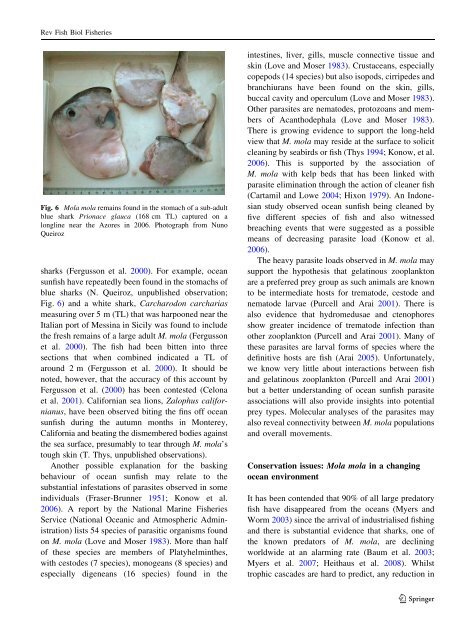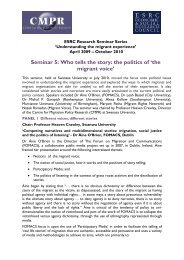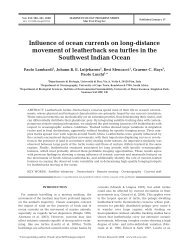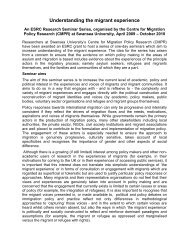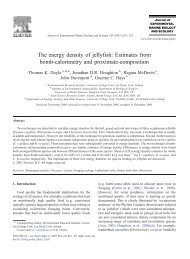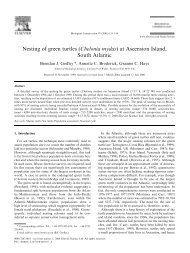The biology and ecology of the ocean sunfish - Swansea University
The biology and ecology of the ocean sunfish - Swansea University
The biology and ecology of the ocean sunfish - Swansea University
You also want an ePaper? Increase the reach of your titles
YUMPU automatically turns print PDFs into web optimized ePapers that Google loves.
Rev Fish Biol Fisheries<br />
Fig. 6 Mola mola remains found in <strong>the</strong> stomach <strong>of</strong> a sub-adult<br />
blue shark Prionace glauca (168 cm TL) captured on a<br />
longline near <strong>the</strong> Azores in 2006. Photograph from Nuno<br />
Queiroz<br />
sharks (Fergusson et al. 2000). For example, <strong>ocean</strong><br />
<strong>sunfish</strong> have repeatedly been found in <strong>the</strong> stomachs <strong>of</strong><br />
blue sharks (N. Queiroz, unpublished observation;<br />
Fig. 6) <strong>and</strong> a white shark, Carcharodon carcharias<br />
measuring over 5 m (TL) that was harpooned near <strong>the</strong><br />
Italian port <strong>of</strong> Messina in Sicily was found to include<br />
<strong>the</strong> fresh remains <strong>of</strong> a large adult M. mola (Fergusson<br />
et al. 2000). <strong>The</strong> fish had been bitten into three<br />
sections that when combined indicated a TL <strong>of</strong><br />
around 2 m (Fergusson et al. 2000). It should be<br />
noted, however, that <strong>the</strong> accuracy <strong>of</strong> this account by<br />
Fergusson et al. (2000) has been contested (Celona<br />
et al. 2001). Californian sea lions, Zalophus californianus,<br />
have been observed biting <strong>the</strong> fins <strong>of</strong>f <strong>ocean</strong><br />
<strong>sunfish</strong> during <strong>the</strong> autumn months in Monterey,<br />
California <strong>and</strong> beating <strong>the</strong> dismembered bodies against<br />
<strong>the</strong> sea surface, presumably to tear through M. mola’s<br />
tough skin (T. Thys, unpublished observations).<br />
Ano<strong>the</strong>r possible explanation for <strong>the</strong> basking<br />
behaviour <strong>of</strong> <strong>ocean</strong> <strong>sunfish</strong> may relate to <strong>the</strong><br />
substantial infestations <strong>of</strong> parasites observed in some<br />
individuals (Fraser-Brunner 1951; Konow et al.<br />
2006). A report by <strong>the</strong> National Marine Fisheries<br />
Service (National Oceanic <strong>and</strong> Atmospheric Administration)<br />
lists 54 species <strong>of</strong> parasitic organisms found<br />
on M. mola (Love <strong>and</strong> Moser 1983). More than half<br />
<strong>of</strong> <strong>the</strong>se species are members <strong>of</strong> Platyhelmin<strong>the</strong>s,<br />
with cestodes (7 species), monogeans (8 species) <strong>and</strong><br />
especially digeneans (16 species) found in <strong>the</strong><br />
intestines, liver, gills, muscle connective tissue <strong>and</strong><br />
skin (Love <strong>and</strong> Moser 1983). Crustaceans, especially<br />
copepods (14 species) but also isopods, cirripedes <strong>and</strong><br />
branchiurans have been found on <strong>the</strong> skin, gills,<br />
buccal cavity <strong>and</strong> operculum (Love <strong>and</strong> Moser 1983).<br />
O<strong>the</strong>r parasites are nematodes, protozoans <strong>and</strong> members<br />
<strong>of</strong> Acanthodephala (Love <strong>and</strong> Moser 1983).<br />
<strong>The</strong>re is growing evidence to support <strong>the</strong> long-held<br />
view that M. mola may reside at <strong>the</strong> surface to solicit<br />
cleaning by seabirds or fish (Thys 1994; Konow, et al.<br />
2006). This is supported by <strong>the</strong> association <strong>of</strong><br />
M. mola with kelp beds that has been linked with<br />
parasite elimination through <strong>the</strong> action <strong>of</strong> cleaner fish<br />
(Cartamil <strong>and</strong> Lowe 2004; Hixon 1979). An Indonesian<br />
study observed <strong>ocean</strong> <strong>sunfish</strong> being cleaned by<br />
five different species <strong>of</strong> fish <strong>and</strong> also witnessed<br />
breaching events that were suggested as a possible<br />
means <strong>of</strong> decreasing parasite load (Konow et al.<br />
2006).<br />
<strong>The</strong> heavy parasite loads observed in M. mola may<br />
support <strong>the</strong> hypo<strong>the</strong>sis that gelatinous zooplankton<br />
are a preferred prey group as such animals are known<br />
to be intermediate hosts for trematode, cestode <strong>and</strong><br />
nematode larvae (Purcell <strong>and</strong> Arai 2001). <strong>The</strong>re is<br />
also evidence that hydromedusae <strong>and</strong> ctenophores<br />
show greater incidence <strong>of</strong> trematode infection than<br />
o<strong>the</strong>r zooplankton (Purcell <strong>and</strong> Arai 2001). Many <strong>of</strong><br />
<strong>the</strong>se parasites are larval forms <strong>of</strong> species where <strong>the</strong><br />
definitive hosts are fish (Arai 2005). Unfortunately,<br />
we know very little about interactions between fish<br />
<strong>and</strong> gelatinous zooplankton (Purcell <strong>and</strong> Arai 2001)<br />
but a better underst<strong>and</strong>ing <strong>of</strong> <strong>ocean</strong> <strong>sunfish</strong> parasite<br />
associations will also provide insights into potential<br />
prey types. Molecular analyses <strong>of</strong> <strong>the</strong> parasites may<br />
also reveal connectivity between M. mola populations<br />
<strong>and</strong> overall movements.<br />
Conservation issues: Mola mola in a changing<br />
<strong>ocean</strong> environment<br />
It has been contended that 90% <strong>of</strong> all large predatory<br />
fish have disappeared from <strong>the</strong> <strong>ocean</strong>s (Myers <strong>and</strong><br />
Worm 2003) since <strong>the</strong> arrival <strong>of</strong> industrialised fishing<br />
<strong>and</strong> <strong>the</strong>re is substantial evidence that sharks, one <strong>of</strong><br />
<strong>the</strong> known predators <strong>of</strong> M. mola, are declining<br />
worldwide at an alarming rate (Baum et al. 2003;<br />
Myers et al. 2007; Heithaus et al. 2008). Whilst<br />
trophic cascades are hard to predict, any reduction in<br />
123


